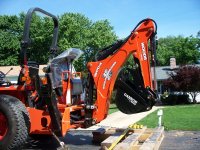A guideline won't do. You will need to figure it out for your self. Even On dry ground, conditions can vary greatly and will be different with different equipment. As you probably know, here in Montana, dry ground can solid with excellent traction, or it can be loose and crumbly, or the vegetation or droppings can be a factor. Dry ground with a lot of pine needle on top can be like marbles.
With that said, I can comfortably go up and down 35 degree (not percent) dry grass slopes and up to 25 deg side slope on my X749. On a JD 110 TLB, a 15 deg side slope is uncomfortable, and is not doable in more slick conditions. I have tried a 15 degree slope on the 110 in slick conditions, it would just slide sideways upon entering the slope. Had to wait until it dried out before it could go there.
For maximum slope, I think a key to the condition is to watch the front tires. If you try to steer up hill and if they slip and go straight or slip downhill, it is definitely too steep. The problem with getting to this point is at that slope and traction condition, you have lost full steering control. To recover requires some serious thought or else the situation can be made worse. Sometimes it feels like playing chess. You make a move, nature counters, you re-assess and make a different move, etc... To be on top of it, you really need to think several moves ahead and consider your risk each step of the way, and know the lay of the land. If you can't stand much risk, keep off slopes greater than the tractor manufacturer recomends. Oh, well maybe that is the guideline.


